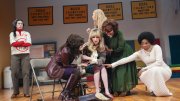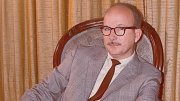
Critic Frank Rich
Craig Lambert writes (“Reviewing ‘Reality,’” March-April, page 40) that New York Times columnist Frank Rich is generally liberal but “equally eager to expose hypocrisy...from the political left.” I disagree. When Rich criticizes a liberal, it is for not adhering faithfully to liberal positions. Rich is adept at sophisticated name calling that adds little to rational debate. Many conservatives use the same debating technique. It isn’t effective in either case.
Frederick Miller ’67
New York City
Shareholder Agendas
“Reforms that make directors...more focused on shareholder interests” are sorely needed, as Lucian A. Bebchuk argues in “Insider Luck” (March-April, page 34). Is there not, however, a conflict between the interests of individual shareholders and the interests of institutional portfolio managers? The latter, who vote millions of shares, have various agendas. An ordinary shareholder (like me) is almost solely interested in income. But a portfolio manager may aspire to directorships or even employment among corporations whose shares he votes—or may be swayed by pure clubbiness, or “star quality” among executives regardless of their performance.
John M. Pickering, M.B.A. ’43
Albuquerque
How To Improve Teaching
I read your report “Toward Top-Tier Teaching” (March-April, page 63) with utter amazement. It took a task force of nine members of the Faculty of Arts and Sciences to propose that teaching should be as important as researching? I can’t imagine that any circumstance could better summarize the ineptitude of academics and the false premise of “higher education.” In blatantly admitting that faculty members ignore classroom innovation and dedication, the panel exposes the self-serving “learning model” that academia propagates. In this model, academics sell the non sequitur that by sheer geographical proximity to ground-breaking scholars, students will develop. Unfortunately, esoteric studies and die-hard allegiance to publish-or-perish demands will never rival the dynamism and effectiveness of passionate teaching as a pedagogical tool.
Those wishing to reform the system should spend a few days across the river at the Business School. While the business faculty is not perfect, it is clear that mediocre teachers are not making tenure.
Jacob Wenz, M.B.A. ’06
Phoenix
A Slippery Phrase
I have both a cheer and a jeer in response to the excellent report by Elizabeth Gudrais on Harvard’s nanopore project for cost-effectively mapping a human genome (“A Personal Genome Machine?” March-April, page 11).
The cheer comes out of personal history. As my wife battled (and ultimately lost her fight to) breast cancer between 1993 and 2000, it seemed increasingly evident to me that whereas every person has a unique genetic makeup, so every person responds uniquely to cancer (and other ailments), as well as to efforts to treat and/or cure the malady. Thus, completely “curing” a cancer patient would require an understanding of the unique chemistry of that person’s individual body. I praise the nanopore project for its invaluable contribution toward precisely that objective.
My jeer stems from collective human history. Gudrais (rightly) raises the question of using individual genome mapping for dark purposes—such as genetic engineering. Higgins professor of biology emeritus Daniel Branton is quoted as saying that that is something “no responsible scientist is contemplating.” I always cringe when I hear that phrase, “no responsible scientist.” It feels very slippery.
In the first place, it’s not the responsible scientists we have to be worried about, it’s the irresponsible ones. Which leads to the heart of the phrase’s flaw: it has a way of implying that all scientists are responsible—that if someone is irresponsible, he or she cannot be a scientist. The history of the twentieth century demonstrates otherwise. The phrase “no responsible scientist” is the scientific world’s version of the classic line, “We’re from the government and we’re here to help you.”
William Hendricks ’72
Dallas
Design Debt
 We warmly thank Vera Leung for her exemplary service while Jennifer Carling, Harvard Magazine’s art director, was on a four-month leave. The past two issues reflect Leung’s skills in acquiring photographs and illustrations, her refined sense of design, and her productivity as she helped us get on press on time (even as we accommodated the late-breaking report on the selection of Harvard’s new president in the March-April issue) while working here evenings and weekends. She is an exceptional colleague, and we want to acknowledge her efforts on our readers’ behalf.
We warmly thank Vera Leung for her exemplary service while Jennifer Carling, Harvard Magazine’s art director, was on a four-month leave. The past two issues reflect Leung’s skills in acquiring photographs and illustrations, her refined sense of design, and her productivity as she helped us get on press on time (even as we accommodated the late-breaking report on the selection of Harvard’s new president in the March-April issue) while working here evenings and weekends. She is an exceptional colleague, and we want to acknowledge her efforts on our readers’ behalf.
~The Editors
Hold the Gitche Gumee
Your celebration of the bicentennial of Henry Wadsworth Longfellow (“The College Pump,” March-April, page 84) seemed to omit his most valuable contributions altogether.
Longfellow’s poetry, popular as it was, can hardly be compared to his studies and accomplishments in modern languages. He graduated from Bowdoin at age 18, was offered a professorship in languages, and studied in Europe, where he became fluent in French, Spanish, Italian, and German. He taught at Bowdoin until 1835 (he was 28), when Harvard offered him the Smith professorship of modern languages. He established the first Romance language department in the United States, published texts in french and Spanish, wrote critical essays for periodicals, and became an outstanding lecturer and literary historian.
On a second voyage to Europe, he concentrated on German and Scandinavian languages (Swedish, Finnish). He also mastered classical languages, Old English, and Provençal. Longfellow translated poetry from many languages, culminating in publication of The Poets and Poetry of Europe in 1845. He translated all of Dante (from 1865 to 1867). He was later called “the first American writer to make a living from poetry.” He retired from teaching in 1854 to spend more time on his own poetry and translation of many other poets.
So: forget the Gitchee-Gumee routine! Give Longfellow credit where he truly deserves it!
Marianne N. Rickabaugh, Ph.D. ’61
San Antonio
Considering National Service
“The Undergraduate” Casey N. Cep’s column on “The War At Home” (March-April, page 75) is one of the best-presented, thought-out perspectives on our citizenry’s losing battle for understanding the essence of national service. I commend her not only for her self-analysis, but for going to the effort to explore the views of classmates.
Jerry D. Lambo, M.B.A. ’64
Colonel, U.S. Army (Retired)
Medford, Ore.
Zane Grey’s Womanizing
Though I am unaware of errors in Thomas Pauly’s “Vita” of Zane Grey (November-December 2006, page 42), I want to alert readers to a serious problem with his recent biography of Grey. Pauly has relied on a single untrustworthy source for one of its more damaging revelations, and his claims about Grey’s philandering are much exaggerated. The book includes a long chapter on Louise Anderson, whom Pauly identifies as Grey’s teenaged mistress—indeed, his only underage lover. Pauly was led to this titillating but false conclusion by a single source: Zane Grey’s son, Loren. At the time of the alleged affair with Louise, Loren was six years old. He was being raised in a chaotic household; his childhood was complicated.
Zane Grey had mistresses, but the teenaged Louise Anderson was not one of them. How do I know? Louise Anderson was my grandmother. Louise’s mother, Nellie Anderson, was one of Zane Grey’s high-school sweethearts, and Louise went west with him several times—on absolutely innocent excursions. If Pauly had been more thorough in his research, he could have discovered this himself. He knew Louise kept a diary of a trip west she took with Zane Grey, but he didn’t attempt to find it. My family has a copy; it’s filled with schoolgirl musings, there’s not a hint of scandal. Nor did Pauly ever find Louise’s birth certificate—he didn’t realize how young she was at the time of her relationship with Grey. When we contacted him, Pauly was surprised to learn that my grandmother was 14 when she met Grey and 14 when she went to stay with his family in California—the time when Pauly claims she and Grey were lovers.
We’ve talked with Pauly’s editor about changes the Illinois Press will make in the unlikely event there is a second printing. In the meantime, we’d like to register our strongest objections to Pauly’s uncritical dissemination of Loren Grey’s version of history.
Gretchen Friesinger ’75
Cambridge
Thomas Pauly replies: Shortly after my book was published, Ms. Friesinger’s mother contacted me with similar complaints. I patiently explained to her several times that I cited Loren Grey only in regard to Nellie Anderson and that my discussion of Louise is supported by many documents (all cited in my notes) that establish beyond all doubt that Zane was romantically and sexually involved with her. Their involvement sorely strained his relationship with his wife, Dolly, and his other girlfriends. Early in my research, I discovered that Louise was 14 when she went traveling with Zane, but in return for permission to quote from Zane’s many letters and journals, Loren requested that I mention only that she was a teenager. Most of Zane’s girlfriends and even Dolly, I should add, were teenagers when he first befriended them.
Errata
In a typographical error, the subtitle of “A President with a Purpose” (March-April, page 46) misstated Gerald R. Ford’s middle initial.
Six photographs in the March-April issue were miscredited. The correct credits are: (page 13) two images depicting the story of Jacob and Esau, to Opera di S. Maria del Fiore, Florence; (page 73) Juliette N. Kayyem, to the Kennedy School of Government, and Gideon Lester, to the American Repertory Theatre; (page 76) Parvinder S. Thiara and Elise Wang, to Stephanie Mitchell/Harvard News Office.
Because of misinformation provided by an image archive, the editors miscaptioned the photograph on page 20 of the January-February issue. “The photo does not show ‘Elizabeth Bishop receiving the 1956 Pulitzer Prize,’” John Ashbery ’49 pointed out. “Rather, it was taken in 1976 at the University of Oklahoma on the occasion of Bishop’s receiving the Neustadt International Prize for literature. I know because I am the mustachioed gent in the background. I had nominated her several months earlier for the award and had gone out to attend the ceremony.”
Speak Up, Please
Harvard Magazine welcomes letters on its contents. Please write to “Letters,” Harvard Magazine, 7 Ware Street, Cambridge 02138, send comments by e-mail to yourturn@harvard.edu, or fax us at 617-495-0324. Letters may be edited to fit the available space.





